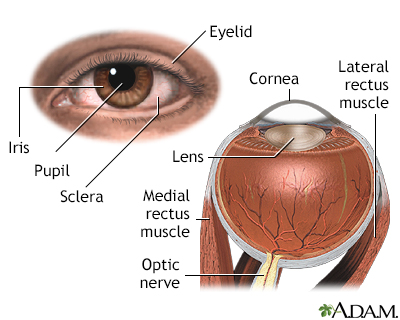Watery eyes
Epiphora; Tearing - increased
Watery eyes means you have too many tears in and draining from the eyes. Tears help keep the surface of the eye moist. They wash away particles and foreign objects in the eye.
Images

I Would Like to Learn About:
Causes
Your eyes always contain tears made by the tear (lacrimal) glands just above the eyes. These tears leave the eye through a small hole in the corner of the eye called the tear duct (nasolacrimal duct).
Causes of watery eyes include:
- Allergy to mold, dander, dust
- Blepharitis (swelling along the edge of the eyelid)
- Blockage of the tear duct
- Conjunctivitis
- Smog or chemicals in the air or wind
- Bright light
- Eyelid turning inward or outward
- Something in the eye (such as dust or sand)
- Scrape on the eye
- Infection
- Inward-growing eyelashes
- Irritation
Increased tearing sometimes happens with:
One of the most common causes of excess tearing is dry eyes. Drying causes the eyes to become uncomfortable, which stimulates the body to produce too many tears. One of the main tests for diagnosing excess tearing is to check whether the eyes are too dry.
Home Care
Treatment depends on the cause of the problem. Therefore, it is important to determine the cause before treating yourself at home.
When to Contact a Medical Professional
Tearing is rarely an emergency. You should seek help right away if:
- Chemicals get into the eye
- You have severe pain, bleeding, or loss of vision
- You have a severe injury to the eye
Also, contact your health care provider if you have:
- A scratch on the eye
- Something in the eye
- Painful, red eyes
- A lot of discharge coming from the eye
- Long-term, unexplained tearing
- Tenderness around the nose or sinuses
What to Expect at Your Office Visit
Your provider will examine your eyes and ask questions about your medical history and symptoms. Questions may include:
- When did the tearing start?
- How often does it happen?
- Does it affect both eyes?
- Do you have vision problems?
- Do you wear contacts or glasses?
- Does the tearing happen after an emotional or stressful event?
- Do you have eye pain or other symptoms, including headache, stuffy or runny nose, or joint or muscle aches?
- What medicines do you take?
- Do you have allergies?
- Did you recently hurt your eye?
- What seems to help stop the tearing?
Your provider may order tests to help determine the cause.
Treatment depends on the cause of the problem.
Related Information
Yawning - excessiveNausea and vomiting – adults
References
Borooah S, Tint NL. The visual system. In: Dover AR, Innes JA, Fairhurst K, eds. Macleod's Clinical Examination. 15th ed. Philadelphia, PA: Elsevier; 2024:chap 8.
Olitsky SE, Marsh JD. Disorders of the lacrimal system. In: Kliegman RM, St. Geme JW, Blum NJ, Shah SS, Tasker RC, Wilson KM, eds. Nelson Textbook of Pediatrics. 21st ed. Philadelphia, PA: Elsevier; 2020:chap 643.
Örge FH. Examination and common problems in the neonatal eye. In: Martin RJ, Fanaroff AA, Walsh MC, eds. Fanaroff and Martin's Neonatal-Perinatal Medicine. 11th ed. Philadelphia, PA: Elsevier; 2020:chap 95.
Seller RH, Symons AB. Vision problems and other common eye problems. In: Seller RH, Symons AB, eds. Differential Diagnosis of Common Complaints. 7th ed. Philadelphia, PA: Elsevier; 2018:chap 34.
BACK TO TOPReview Date: 11/6/2023
Reviewed By: Neil K. Kaneshiro, MD, MHA, Clinical Professor of Pediatrics, University of Washington School of Medicine, Seattle, WA. Also reviewed by David C. Dugdale, MD, Medical Director, Brenda Conaway, Editorial Director, and the A.D.A.M. Editorial team.

Health Content Provider
06/01/2025
|
A.D.A.M., Inc. is accredited by URAC, for Health Content Provider (www.urac.org). URAC's accreditation program is an independent audit to verify that A.D.A.M. follows rigorous standards of quality and accountability. A.D.A.M. is among the first to achieve this important distinction for online health information and services. Learn more about A.D.A.M.'s editorial policy, editorial process and privacy policy. A.D.A.M. is also a founding member of Hi-Ethics. This site complied with the HONcode standard for trustworthy health information from 1995 to 2022, after which HON (Health On the Net, a not-for-profit organization that promoted transparent and reliable health information online) was discontinued. |
The information provided herein should not be used during any medical emergency or for the diagnosis or treatment of any medical condition. A licensed medical professional should be consulted for diagnosis and treatment of any and all medical conditions. Links to other sites are provided for information only -- they do not constitute endorsements of those other sites. © 1997- 2025 A.D.A.M., a business unit of Ebix, Inc. Any duplication or distribution of the information contained herein is strictly prohibited.
